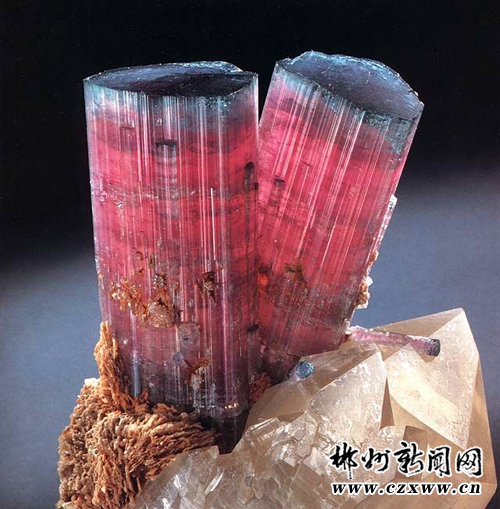First Look of Third China (Hunan) International Mineral & Gem Show: Tourmaline

Chinese gem industry called the tourmaline as “Bi Xi”. “Xi” referred to the seal of emperor. Just from the name, you can tell how precious it was in the ancient times. According to current archaeology, there were tourmalines available from Yuan Dynasty. Till Ming & Qing Dynasty, it became more popular that tourmaline sculptures, pendants, rings, snuff bottles, and etc. were available.
It was recorded that tourmaline was first found and used in Cruzeiro of Brazil in 1674. Local people mistook it as emerald for the tourmaline’s green color and columnar shape are similar to emerald. It was explored and sales as emerald since then for people had no idea of tourmaline at that time.
According to the legend, on a day of 18th century, some kids played a kind of transparent but hard green stones which were brought back by their father from the America on the seaside of Amsterdam of the Netherlands. They were surprised to find the stones can adsorb dust and turfgrass clippings, so they told their parents and showed to them. Some scientists learned that case and confirmed that it was pyroelectric phenomenon caused by friction, rather than the feature of the aquamarine stone, so the stone was named as tourmaline.
The most important production place of the tourmaline is Minas Gerais of Brazil where is famous as “the world’s treasury”. It is a kind of primary deposit which is an outcome of magmation generated in the fracture or abra of near-surface or underground. It is also available in Altay in Xinjiang province, Ailaoshan in Yunnan province and some other places of China. Green, blue and pink color items are available there.
Due to its complicated elements and medium price level, there is no synthetic of tourmaline available in the market. The most ordinary counterfeit of tourmaline is glass which can be identified not so difficultly. The birefringence of tourmaline is high, so when you observe it via magnifying lens downward, there is slur phenomenon on the corner angle of the bottom (just turning the gem to find the most obvious direction). But for glass, no such slur phenomenon available, because it is not crystal item. Furthermore, the thermoelectricity effect is obvious for the tourmaline, so when you heat one end of the tourmaline (incandescent bulb with higher wattage is ok), electric charge would be generated in the other end and can absorb small piece of paper. But for the glass, it is not with such thermoelectricity feature.
But crystal is also with thermoelectricity, if encountered with two-tone crystal which is used as counterfeit of watermelon tourmaline, we can only identify its refractive index by refractometer. Furthermore, the pleochroism of tourmaline is much more obvious than crystal, which is also a very important factor for identification.
There is a beautiful pink or red tourmaline whose light color is deepened by radioactivity is available at present market. The finished product is with radioactivity which can be identified by some devices. The radioactivity would fade after a period of time. The dark color of this fake product would also fade and recover to its origin light color. Some consumers were deceived by this kind of fake products. But currently, there is no better way to identify it.




